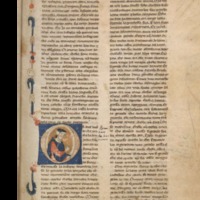
Ronald G. Musto
Ronald G. Musto holds a Ph.D. in History from Columbia University and specializes in the Italian Trecento, with a focus on Rome and Naples. He has served as an adjunct professor at Columbia, NYU, and Duke universities. He has held Renaissance Society of America, American Academy in Rome, National Endowment for the Humanities, and Mellon Foundation fellowships and published twelve books and various articles, including The Catholic Peace Tradition (National Catholic Book Award, 1986); Apocalypse in Rome: Cola di Rienzo and the Politics of the New Age (AHA Marraro Prize, 2004); and Renaissance Society and Culture (ed., with John Monfasani).
He has worked in the book trade since 1967 and in 1985 with Dr. Eileen Gardiner he cofounded Italica Press, where he has developed numerous print and electronic projects. With Dr. Gardiner he has co-authored “The Electronic Book” in The Oxford Companion to the Book, and in The Book: A Global History. They are co-authors of The Digital Humanities: A Primer (Cambridge University Press, 2015).
Ronald Musto is general editor of the six-volume Documentary History of Naples and author of Medieval Naples: A Documentary History, 400-1400 (2013). Among his articles are "Queen Sancia of Naples (1286–1345) and the Spiritual Franciscans" (Basil Blackwell, 1985); “Franciscan Joachimism at the Court of Naples, 1305–1345: A New Appraisal” (Archivum Franciscanum Historicum, 1997);" "Angevin Manuscripts and the Visualization of Power in the Reign of Giovanna I of Naples" (Visual History, 2016); “Introduction: Naples in Myth and History,” in Marcia B. Hall and Thomas Willette, Artistic Centers of the Italian Renaissance: Naples (New York: Cambridge University Press, 2017); and several articles in the Dictionary of Art and Oxford Bibliographies Online for Rome, Naples, and Southern Italy. Dr. Musto's reviews of books on medieval and early modern Rome, Naples, and Southern Italy have appeared regularly in Renaissance Quarterly and other journals. His study of trecento historians of the Italian Mezzogiorno, entitled Writing Southern Italy before the Renaissance (Routledge, 2019), is now in its second, revised edition (Italica Press, 2022).
Dr. Musto's newest book, The Attack on Higher Education: The Dissolution of the American University (Cambridge University Press, 2021) has been listed among Forbes Magazine's 10 Best Books in Higher Education in 2022.
In the 1990s he served on the Board of the Society of Fellows of the American Academy in Rome and was editor of its SOF News. From 1999 to 2011 he served, with Eileen Gardiner, as co-Director of Humanities E-Book for the American Council of Learned Societies; and from September 2011 to April 2013, with Eileen Gardiner, as Executive Director/Editor of Speculum for the Medieval Academy of America. He is a Research Fellow (Hon.) at the Centre for Medieval Studies, University of Bristol, UK. He serves as a Member of the Executive Committee for the Centre and as Co-Editor of the University of Bristol, Studies in Medieval Cultures.
Address: Bristol, United Kingdom
He has worked in the book trade since 1967 and in 1985 with Dr. Eileen Gardiner he cofounded Italica Press, where he has developed numerous print and electronic projects. With Dr. Gardiner he has co-authored “The Electronic Book” in The Oxford Companion to the Book, and in The Book: A Global History. They are co-authors of The Digital Humanities: A Primer (Cambridge University Press, 2015).
Ronald Musto is general editor of the six-volume Documentary History of Naples and author of Medieval Naples: A Documentary History, 400-1400 (2013). Among his articles are "Queen Sancia of Naples (1286–1345) and the Spiritual Franciscans" (Basil Blackwell, 1985); “Franciscan Joachimism at the Court of Naples, 1305–1345: A New Appraisal” (Archivum Franciscanum Historicum, 1997);" "Angevin Manuscripts and the Visualization of Power in the Reign of Giovanna I of Naples" (Visual History, 2016); “Introduction: Naples in Myth and History,” in Marcia B. Hall and Thomas Willette, Artistic Centers of the Italian Renaissance: Naples (New York: Cambridge University Press, 2017); and several articles in the Dictionary of Art and Oxford Bibliographies Online for Rome, Naples, and Southern Italy. Dr. Musto's reviews of books on medieval and early modern Rome, Naples, and Southern Italy have appeared regularly in Renaissance Quarterly and other journals. His study of trecento historians of the Italian Mezzogiorno, entitled Writing Southern Italy before the Renaissance (Routledge, 2019), is now in its second, revised edition (Italica Press, 2022).
Dr. Musto's newest book, The Attack on Higher Education: The Dissolution of the American University (Cambridge University Press, 2021) has been listed among Forbes Magazine's 10 Best Books in Higher Education in 2022.
In the 1990s he served on the Board of the Society of Fellows of the American Academy in Rome and was editor of its SOF News. From 1999 to 2011 he served, with Eileen Gardiner, as co-Director of Humanities E-Book for the American Council of Learned Societies; and from September 2011 to April 2013, with Eileen Gardiner, as Executive Director/Editor of Speculum for the Medieval Academy of America. He is a Research Fellow (Hon.) at the Centre for Medieval Studies, University of Bristol, UK. He serves as a Member of the Executive Committee for the Centre and as Co-Editor of the University of Bristol, Studies in Medieval Cultures.
Address: Bristol, United Kingdom
less
Related Authors
Alex Metcalfe
Lancaster University
Florin Curta
University of Florida
Antonio Musarra
Sapienza University of Roma
Tommaso di Carpegna Falconieri
Urbino "Carlo Bo"
Carlo Ebanista
Università del Molise
Francisca Noguerol
University of Salamanca
Matteo Cambi
Università di Pisa
Rosa Maria Dessì
Université Nice Sophia Antipolis
paolo rosso
Università degli Studi di Torino
Enrico Faini
Università degli Studi di Firenze (University of Florence)
InterestsView All (12)










Uploads
Forthcoming Publications by Ronald G. Musto
Coverage included anthropology and sociology, history, contemporary and historical art, literature and criticism, religion, philosophy, architecture and urbanism, politics, the performing arts and media, science, current events and cultural icons. Its authors were among the most prominent cultural figures and public thinkers of the day.
This forthcoming book in Cambridge UP's Elements in Publishing and Book Culture series will cover Horizon’s cultural and publishing contexts, its editorial philosophy, goals and assumptions; authors and content; production values, publication models, and economics; audience, reception, and impact. It will trace diachronically and thematically how and why Horizon’s iconic success and failure mirrored the rise and decline of a supposedly common American mid-century culture.
Books by Ronald G. Musto
Ronald G. Musto brings to bear current methodological and theoretical frameworks to develop this analysis. Central to his examination are the role of trecento visual language and the impact of fictional forms on this historiography. He traces the fine line between historia and fabula and the ability of trecento writers to absorb and utilize the symbolic forms deployed by such artists as Giotto, Lorenzetti and Francesco da Barberino and such romances as Meliadus, the Contesse d’Anjou and Constance.
To illustrate and test these analyses, Musto offers case studies examining rituals of punishment and prison dialogues. He traces the development of a grand narrative — the black legend of the Angevins — through Petrarch, Villani, Boccaccio and Gravina. A final chapter compares trecento historiography to that of the southern humanists.
This second, revised edition is published by special arrangement with Routledge. It presents revised text; revised and updated notes; a chronology of persons and events; and a complete, updated and comprehensive bibliography. It also incorporates selected new source materials and secondary research published since that first edition. For consistency of reference, all numbering of chapters, subsections, annotation and pagination remain the same as in the hardcover edition.
For details, see:
https://www.cambridge.org/us/academic/subjects/education/education-history-theory/attack-higher-education-dissolution-american-university
Digital Projects by Ronald G. Musto
Articles by Ronald G. Musto
Coverage included anthropology and sociology, history, contemporary and historical art, literature and criticism, religion, philosophy, architecture and urbanism, politics, the performing arts and media, science, current events and cultural icons. Its authors were among the most prominent cultural figures and public thinkers of the day.
This forthcoming book in Cambridge UP's Elements in Publishing and Book Culture series will cover Horizon’s cultural and publishing contexts, its editorial philosophy, goals and assumptions; authors and content; production values, publication models, and economics; audience, reception, and impact. It will trace diachronically and thematically how and why Horizon’s iconic success and failure mirrored the rise and decline of a supposedly common American mid-century culture.
Ronald G. Musto brings to bear current methodological and theoretical frameworks to develop this analysis. Central to his examination are the role of trecento visual language and the impact of fictional forms on this historiography. He traces the fine line between historia and fabula and the ability of trecento writers to absorb and utilize the symbolic forms deployed by such artists as Giotto, Lorenzetti and Francesco da Barberino and such romances as Meliadus, the Contesse d’Anjou and Constance.
To illustrate and test these analyses, Musto offers case studies examining rituals of punishment and prison dialogues. He traces the development of a grand narrative — the black legend of the Angevins — through Petrarch, Villani, Boccaccio and Gravina. A final chapter compares trecento historiography to that of the southern humanists.
This second, revised edition is published by special arrangement with Routledge. It presents revised text; revised and updated notes; a chronology of persons and events; and a complete, updated and comprehensive bibliography. It also incorporates selected new source materials and secondary research published since that first edition. For consistency of reference, all numbering of chapters, subsections, annotation and pagination remain the same as in the hardcover edition.
For details, see:
https://www.cambridge.org/us/academic/subjects/education/education-history-theory/attack-higher-education-dissolution-american-university
This précis forms the nucleus of a work I hope to launch in the coming year. Your comments are most welcome
Folios 259v–275v depict Naples as the stand-in for Arthurian Leonnois; and these preparatory drawings contain one of the city’s earliest, complete, and detailed perspectives from the Campus Neapolitanus, more accurate than the Metropolitan Museum of Art’s Charles III cassone of c.1382. To the right (recto) spreads King Arthur’s camp. To the left, on the facing versos, appears the characteristic combination of Ponte della Maddelena (Guizzardo) crossing over the Sebeto to Porta Maddelena (Carmine), marked throughout by the same high-arched, crenellated, and shallow rectangular form depicted in the Metropolitan’s cassone. Behind them rises the church of Sant’Agostino alla Zecca with its three-tiered tower, turret with its orb and cross, and bifore. In the center looms Castel Capuano. To the right rises S. Giovanni a Carbonara, here with its trecento campanile. We compare and verify this topography with the same relationships in the Tavola Strozzi of 1472/73.
These illustrations bear a close relationship to a drawing for the eventual program for the triumphal arch of Alfonso I at Castel Nuovo. The drawing (now in Rotterdam) is attributed to Pisanello. Pisanello accepted Alfonso’s invitation to work in Naples between 1449 and the mid-1450s and was appointed court artist to do disegni, including manuscript illustration. I propose that Pisanello’s authorship is supported by the textual and visual evidence. Comparing these BL drawings to Pisanello’s known corpus in forthcoming work, I note the close correspondences in chivalric subject matter, composition, perspective, drawing style and technique, and individual details of architecture, arms, armor, horses, and combat to derive a more firm attribution of the BL manuscript's later illustrations to him and his workshop.
I propose that folios 259v–275v depict Naples as the stand-in for Arthurian Leonnois and that these preparatory drawings contain one of the city’s earliest, complete, and detailed perspectives from the Campus Neapolitanus, more accurate than the Metropolitan Museum of Art’s Charles III cassone of c.1382. To the right (recto) spreads King Arthur’s camp. To the left, on the facing versos, appears the characteristic combination of Ponte della Maddalena (Guizzardo) crossing over the Sebeto to Porta Maddalena (Carmine), marked throughout by the same high-arched, crenellated, and shallow rectangular form depicted in the Metropolitan’s cassone. Behind them rises the church of Sant’Agostino alla Zecca with its three-tiered tower, turret with its orb and cross, and bifore. In the center Castel Capuano. To the right S. Giovanni a Carbonara, here with a campanile contemporary with the original building. We will compare and verify this topography with the same relationships in the Tavola Strozzi of 1472/73.
These illustrations bear a close relationship to a drawing for the eventual program for the triumphal arch of Alfonso I at Castel Nuovo. The drawing (now in Rotterdam) is attributed to Pisanello. Comparing these BL drawings to Pisanello’s known corpus, I note the close correspondences in chivalric subject matter, composition, perspective, drawing style and technique, and individual details of architecture, arms, armor, horses, and combat. Pisanello accepted Alfonso’s invitation to work in Naples between 1449 and the mid-1450s and was appointed court artist to do disegni, including manuscript illustration. I propose that Pisanello’s authorship is supported by the visual evidence and warrants further investigation. If accepted, this thesis would date this view of Naples to c.1450.
Natural disaster had also been a backdrop for the foundering ship of state of Giotto’s Navicella, Cola di Rienzo’s appropriation of Giotto’s imagery, and in Petrarch’s critiques of trecento Rome. According to Petrarch, in Naples the works of civilization, “constructed by zealous men,” were overturned to their foundations by unleashed forces, “which that day respected no bounds and respected no work of man or nature.” The waters of the sea, recalling those of untamed Chaos before the creation, become a metaphor for the rule of the untamed, monstrous woman. Citing Julia Kristeva, Sarah Alison Miller called attention to this deeply imbedded idea of medieval writers on the female body “which ‘disturbs identity, system, order,’ that ‘does not respect boundaries, positions, rule’” and that is closely associated with waters. Petrarch thus turned observation of the natural world into personal and political metaphor that underlay the narrative arc for his experience of Naples under Giovanna I.
Deploying insights from such recent work as Disaster Narratives in Early Modern Naples and my own Writing Southern Italy before the Renaissance, this paper analyzes Familiares V.5’s narrative, rhetorical, and metaphorical strategies. But it also asks how this account squares with modern scientific findings and the record of Petrarch’s contemporaries. Did other writers — including the Anonimo Romano, Villani, Boccaccio, the Cronaca di Partenope, the Cronicon Siculum, and Domenico da Gravina — leave any historical memory of this event? How will a comparative approach to such sources reveal how disaster is transformed into narrative, metaphor, and political discourse?
Using Manekine, Belle Hélène de Constantinople, the Roman du Comte d’Anjou and Melusine, this paper probes the permeable boundaries between fictive and factual narratives of accused queens and how this porosity allowed writers such as the Villani, Gravina, Petrarch and Boccaccio to employ a vocabulary and grammar of available plot elements, characters, motifs and devices to provide the details of interior thought and motivation, to supply missing details of events and to draw out character beyond the available conventions of hagiography and royal biography. In so doing these writers were able to deploy dramatizations of female inheritance and male privilege, internal dynastic conflict, female perversion or nobility that were readily recognizable to their audiences.
I will also touch on the visual uses of texts such as Meliadus de Leonnois (BL Add 12228), the Statutes of the Order of the Knot (BNF 4274) and the Anjou Bible (Maurits Sabbe 1) to demonstrate the ease with which Angevin rulers inserted themselves into the fabric of chivalric romance and sacred history to bolster dynastic claims at home and abroad.